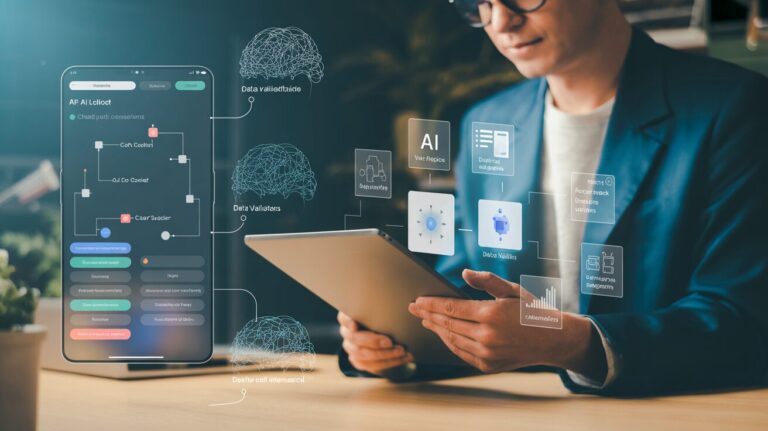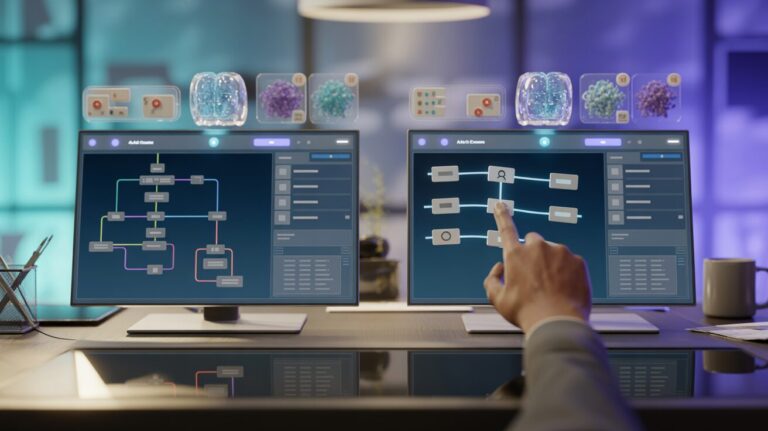Table Of Contents
- Understanding AI Processing Workflows: The Fundamentals
- Batch Processing Explained: Benefits, Limitations, and Use Cases
- Real-Time Processing Explained: Benefits, Limitations, and Use Cases
- Side-by-Side Comparison: Batch vs. Real-Time AI Processing
- Choosing the Right Workflow for Your Business Needs
- Implementing AI Processing Workflows Without Coding Expertise
- Future Trends in AI Processing Workflows
- Conclusion: Empowering Your Business with the Right AI Processing Approach
In today’s rapidly evolving AI landscape, businesses face a crucial decision when implementing artificial intelligence solutions: should they process data in batches or in real-time? This choice fundamentally impacts how AI applications perform, scale, and deliver value to organizations and users alike.
Whether you’re a content creator looking to analyze large datasets of user engagement, a healthcare professional needing instant analysis of patient information, or a small business owner wanting to automate customer interactions, understanding the difference between batch and real-time AI processing workflows is essential to building effective AI solutions.
The good news? You no longer need to be a data scientist or programmer to implement these powerful AI workflows. This comprehensive guide will break down batch and real-time processing approaches in plain language, help you determine which is right for your specific needs, and demonstrate how modern no-code platforms are making these sophisticated AI capabilities accessible to everyone.
Batch vs Real-Time AI Processing
A strategic guide to choosing the right AI workflow for your business needs
Batch Processing
Processing data in scheduled intervals or when sufficient volume accumulates.
Ideal For:
- Large data volume analysis
- Resource-efficient processing
- Complex, thorough algorithms
- Non-urgent insights & reporting
Use Cases:
Real-Time Processing
Analyzing and acting on data immediately as it arrives or is generated.
Ideal For:
- Time-sensitive applications
- Interactive user experiences
- Continuous data streams
- Immediate decision-making
Use Cases:
Side-by-Side Comparison
Batch Processing
- Timing: Scheduled intervals
- Response: Minutes to days
- Efficiency: High for large volumes
- Cost: More cost-effective
Real-Time Processing
- Timing: Immediately as data arrives
- Response: Milliseconds to seconds
- Efficiency: Optimized for responsiveness
- Cost: Can be more expensive
Choosing the Right Workflow
Key Questions to Ask:
- How time-sensitive is your use case?
- What volume of data are you processing?
- What are your resource constraints?
- How complex is your analysis?
Consider Hybrid Approaches:
- Real-time pre-processing with batch deep analysis
- Batch model training with real-time inference
- Tiered response systems with immediate preliminary results
Implement AI Without Coding
Modern no-code platforms like Estha enable professionals from diverse backgrounds to build and deploy both batch and real-time AI processing workflows without writing a single line of code.
Understanding AI Processing Workflows: The Fundamentals
At its core, an AI processing workflow determines how and when your data gets analyzed by artificial intelligence algorithms. Think of it as the assembly line for your data—it dictates whether items get processed one at a time as they arrive or collected into groups for processing at scheduled intervals.
Before diving into the specifics of batch and real-time processing, let’s establish a foundational understanding of AI workflows. An AI workflow typically consists of several key steps: data collection, data preparation, model application, result generation, and action implementation. The primary difference between batch and real-time processing lies in when and how frequently these steps occur.
The choice between batch and real-time processing isn’t simply a technical decision—it directly impacts user experience, resource utilization, cost efficiency, and business outcomes. Getting this decision right can mean the difference between an AI solution that delivers tremendous value and one that fails to meet expectations.
Batch Processing Explained: Benefits, Limitations, and Use Cases
Batch processing is the approach of collecting data over a period of time and processing it all at once according to a schedule or when a sufficient volume has accumulated. Think of it like doing your laundry—you don’t wash individual items as they get dirty; you wait until you have a full load before running the washing machine.
Key Benefits of Batch Processing
Batch processing offers several distinct advantages that make it ideal for certain use cases:
Resource Efficiency: By processing data in large batches, organizations can maximize computational efficiency and minimize overhead costs. Systems can be optimized for throughput rather than responsiveness, often allowing more data to be processed with fewer resources.
Predictable System Load: Batch processing creates predictable demands on computing resources, making it easier to schedule jobs during off-peak hours and manage system capacity. This predictability often translates to cost savings and more stable performance.
Comprehensive Analytics: When analyzing data in batches, you can apply more complex, thorough algorithms that might be too computationally expensive to run in real-time. This enables deeper insights and more sophisticated analysis.
Error Recovery: Batch systems typically have robust error handling capabilities. If an error occurs during processing, the system can easily restart the batch from a checkpoint without data loss.
Limitations of Batch Processing
Despite its advantages, batch processing isn’t suitable for all scenarios:
Delayed Insights: The most significant limitation is the inherent delay between data collection and processing. Users must wait for the next scheduled batch run to see results, which can limit responsiveness.
Less Suitable for Time-Sensitive Applications: Any use case requiring immediate responses will suffer from batch processing’s inherent latency.
Potentially Outdated Results: By the time a batch is processed, the underlying conditions that generated the data may have changed, potentially leading to outdated insights or recommendations.
Common Batch Processing Use Cases
Content Analysis and Categorization: Media companies and content platforms often use batch processing to analyze, tag, and categorize large libraries of content during off-peak hours.
Monthly Business Reporting: Financial analysis, sales performance, and other business metrics that follow monthly, quarterly, or annual cycles are well-suited to batch processing.
Training AI Models: The initial training of AI models typically occurs in batch mode, processing large datasets to establish patterns and correlations.
Data Warehousing: ETL (Extract, Transform, Load) processes that populate data warehouses typically run as batch jobs, consolidating data from various sources on a regular schedule.
Real-Time Processing Explained: Benefits, Limitations, and Use Cases
Real-time processing, as the name suggests, involves analyzing and acting on data immediately as it’s generated or received. Using our laundry analogy, this would be like washing each garment individually the moment it becomes dirty—less efficient perhaps, but providing clean clothes exactly when needed.
Key Benefits of Real-Time Processing
Real-time processing shines in scenarios where immediacy is paramount:
Immediate Insights and Actions: The most obvious benefit is the ability to generate insights and take actions without delay, enabling responsive systems that feel instantaneous to users.
Enhanced User Experience: Applications that respond immediately to user input create a more engaging and satisfying experience, which can translate to higher user retention and satisfaction.
Time-Sensitive Decision Making: For scenarios where conditions change rapidly or where delayed responses could have significant consequences, real-time processing is essential.
Competitive Advantage: Being able to act on information faster than competitors can create significant market advantages in many industries.
Limitations of Real-Time Processing
Real-time systems face their own set of challenges:
Higher Resource Requirements: Maintaining systems that can process data immediately typically requires more computing power and can result in higher operational costs.
Limited Processing Depth: The need for immediate responses often means simplifying algorithms or limiting the scope of analysis to meet speed requirements.
Complexity in System Design: Building robust real-time systems requires careful architecture to handle variable loads and ensure reliability under pressure.
Potential for Information Overload: Without the filtering effect that batch processing naturally provides, real-time systems can sometimes overwhelm users with too many notifications or updates.
Common Real-Time Processing Use Cases
Conversational AI and Chatbots: Virtual assistants and chatbots must process and respond to user queries immediately to maintain natural conversation flow.
Fraud Detection: Financial institutions need to identify suspicious transactions as they occur, not hours or days later after funds have been transferred.
Recommendation Engines: E-commerce platforms and content services benefit from updating recommendations based on a user’s most recent actions.
Healthcare Monitoring: Patient monitoring systems need to alert healthcare providers to critical conditions immediately as vital signs indicate problems.
Dynamic Pricing: Travel, hospitality, and retail businesses often adjust prices in real-time based on demand, inventory levels, and competitor pricing.
Side-by-Side Comparison: Batch vs. Real-Time AI Processing
To help clarify the differences between these two approaches, let’s compare them directly across several key dimensions:
| Factor | Batch Processing | Real-Time Processing |
|---|---|---|
| Processing Timing | Scheduled intervals or when sufficient data accumulates | Immediately as data arrives |
| Response Time | Minutes to hours or days | Milliseconds to seconds |
| Resource Efficiency | High (optimized for throughput) | Lower (optimized for responsiveness) |
| Cost Efficiency | Generally more cost-effective for large volumes | Can be more expensive due to always-on requirements |
| Complexity of Analysis | Can support very complex, resource-intensive algorithms | Often limited to simpler or optimized algorithms |
| Data Volume Handling | Excellent for very large datasets | Better for continuous streams of smaller data points |
| Error Recovery | Typically robust with checkpoint capabilities | More challenging; may lose data if system fails |
| Typical Applications | Reporting, analytics, model training, data warehousing | Chatbots, monitoring, recommendations, dynamic systems |
Choosing the Right Workflow for Your Business Needs
Selecting between batch and real-time processing isn’t always an either/or decision. Many sophisticated AI applications actually employ both approaches, leveraging each for what it does best. Here’s a framework to help guide your decision-making process:
Questions to Consider When Choosing Your AI Processing Approach
How time-sensitive is your use case? If users expect immediate responses or if the value of your insights degrades quickly with time, real-time processing is likely necessary.
What volume of data are you processing? Very large datasets may be more efficiently handled through batch processing, especially if the results aren’t needed immediately.
What are your resource constraints? If you’re operating with limited computing resources or budget constraints, batch processing often provides more bang for your buck.
How complex is your analysis? Highly sophisticated algorithms that require significant computational resources may need to run in batch mode, while simpler models can operate in real-time.
What’s your error tolerance? If absolute accuracy is essential and you can afford some delay, batch processing often allows for more thorough validation and error checking.
Hybrid Approaches: Getting the Best of Both Worlds
Many successful AI implementations actually combine both processing methods:
Real-time Pre-processing with Batch Deep Analysis: Some systems use real-time processing for immediate, basic insights while queueing the same data for more thorough batch analysis later.
Batch Model Training with Real-time Inference: AI models are typically trained using batch processing on historical data, but then deployed to make real-time predictions on new data as it arrives.
Tiered Response Systems: These provide immediate preliminary results via real-time processing, followed by refined results from batch processing as they become available.
Implementing AI Processing Workflows Without Coding Expertise
Traditionally, implementing sophisticated AI workflows required deep technical expertise in programming, data science, and system architecture. However, the landscape has dramatically changed with the emergence of no-code AI platforms that democratize access to these powerful technologies.
Today’s no-code platforms enable professionals from diverse backgrounds to build and deploy both batch and real-time AI processing workflows without writing a single line of code. Here’s how different professionals can leverage these platforms:
No-Code AI Implementation Examples
For Content Creators: A content creator could implement a real-time AI assistant that immediately helps users navigate their content library, while also using batch processing overnight to analyze engagement patterns and optimize content categories.
For Educators: An educator might create an interactive quiz system that provides immediate feedback to students (real-time processing) while also conducting batch analysis of performance trends across classes to identify areas where the curriculum needs strengthening.
For Healthcare Professionals: A healthcare provider could deploy a patient intake system that uses real-time processing to flag urgent concerns immediately, while batch processing patient population data weekly to identify emerging health trends.
For Small Business Owners: A retailer could implement a customer service chatbot that handles inquiries in real-time, while also running batch processing on customer interaction data to identify common questions that should be addressed in FAQs or product descriptions.
With platforms like Estha, these implementations no longer require technical expertise. Using intuitive drag-drop-link interfaces, professionals can visually design their AI workflows, connecting data sources to processing steps to output formats without writing code.
Future Trends in AI Processing Workflows
As AI technology continues to evolve, several emerging trends are reshaping how we think about batch and real-time processing:
Stream Processing Convergence: The line between batch and real-time is blurring with the rise of stream processing frameworks that can handle both paradigms within a single system, offering more flexibility in implementation.
Edge Computing Integration: Processing at the edge (on devices rather than in central servers) is enabling new hybrid models where initial real-time processing happens locally, with more complex batch processing in the cloud.
Automated Workflow Optimization: AI systems themselves are beginning to determine the optimal processing approach dynamically based on data characteristics, urgency, and resource availability.
Increased Accessibility: The continued evolution of no-code platforms is making both batch and real-time AI processing workflows accessible to an ever-wider audience of non-technical professionals.
These trends point toward a future where the technical distinctions between batch and real-time processing become less relevant to end-users. Instead, AI systems will intelligently select the appropriate processing model behind the scenes while presenting a unified, responsive interface to users.
Conclusion: Empowering Your Business with the Right AI Processing Approach
The choice between batch and real-time AI processing workflows isn’t simply a technical decision—it’s a strategic business choice that impacts user experience, resource utilization, and ultimately, the value your AI solutions deliver.
Understanding the fundamental differences between these approaches empowers you to make informed decisions about how best to implement AI in your specific context. While batch processing excels at handling large volumes of data efficiently for non-urgent insights, real-time processing delivers immediate responses that enhance user experiences and enable time-sensitive applications.
Most importantly, thanks to the democratization of AI through no-code platforms, implementing either approach—or a hybrid of both—is now within reach regardless of your technical background. Today’s professionals across industries can leverage sophisticated AI processing workflows to solve problems, create value, and innovate without dependency on technical teams.
As you consider your own AI implementation needs, focus first on understanding your specific requirements—the time sensitivity of your use case, the volume of data involved, your resource constraints, and the complexity of your analysis. With this clarity, you can confidently choose the right processing approach and begin building solutions that leverage the power of AI to transform your business or practice.
Ready to build your own AI processing workflows without coding?
Whether you need batch processing for deep analysis or real-time responses for interactive applications, Estha’s no-code platform makes it simple to create, deploy, and scale custom AI solutions in minutes.



